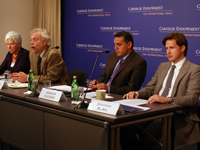Registration
Thank you!
You will receive an email confirming your registration.
IMGXYZ3235IMGZYXThe relation between religion and politics has long caused contention in Egyptian politics. Now, the ongoing revolutionary changes in the country have brought new actors to prominence (including Salafi and Sufi movements) and posed sharp new questions about religion and the constitution, the official religious establishment, and the role of religious groups in the electoral process.
To examine these new questions and trends in Egyptian politics and Islam, Carnegie hosted a panel discussion featuring Carnegie’s Nathan Brown, Georgetown University's Jonathan Brown, and the Brookings Institution's Khaled Elgindy. Carnegie's Marina Ottaway moderated the discussion.
Trends in Post-Revolutionary Egypt
- Religion and the State: Elgindy observed that the nexus of religion and the state is at the center of the political and social debates in Egypt today.
- Levels of change: While there are changes taking place at the national government level, many of the post-revolutionary trends in Egypt are occurring at the micro-level within institutions such as universities, unions, and government ministries, Nathan Brown said. Al-Azhar, which is an educational complex, scholarly center, and religious institution, is one of these institutions undergoing change.
- Christian institutions: In addition to the Muslim religious institutions, similar changes are taking place with the Coptic Christian establishments in Egypt, Elgindy added.
- Student elections in al-Azhar: In the most recent, post-revolutionary student government elections in al-Azhar University, the Muslim Brotherhood won control of most of the faculties, although the effect of these victories is not yet clear, Nathan Brown observed.
Role of al-Azhar
- Greater independence: Nathan Brown argued that while Egypt’s disparate actors agree on the need for greater independence for al-Azhar, there are competing visions for what the institution’s role in Egyptian political and social life should be.
- Wasatiyya: Sheikh Ahmed al-Tayyib, the current Grand Imam of al-Azhar, has articulated a wasatiyya (centrist) vision of the role of Islam in modern life, in contrast to the textualist conception of many of the Salafi preachers, Nathan Brown said. Al-Tayyib has also called for al-Azhar to reclaim its international role as a beacon of Islamic learning.
- Ripple Effect: The outcome of the debate on the role of al-Azhar will be a determining factor in other state-society relationships in Egypt, Elgindy argued.
- Relationship to Islamist movements: Al-Azhar and its scholars have a complex relationship to the Islamist movements; while some Azhar scholars are members of Islamist groups like the Muslim Brotherhood, others criticize the Muslim Brotherhood’s perceived usurpation of some of al-Azhar’s authority, Nathan Brown said.
Salafi movements
- Pre-revolution: Prior to the revolution, Salafist groups were largely apolitical and ceded control over the political domain to the state, Jonathan Brown stated. This can in part be explained by their precarious position under the Mubarak regime, which allowed them to spread religious ideas but not engage in political activities.
- Membership in other organizations: Jonathan Brown added that there is diversity within the Salafi community in Egypt: some Salafis are affiliated with al-Azhar some are members in the Muslim Brotherhood, some have rejected the idea of a civil state, and others have embraced it.
- Post-revolution: The international and domestic mainstream media in Egypt have focused on the rise of the Salafis and some of the controversial statements of a few of the Salafi leaders particularly following a number of attacks on Sufi shrines by Salafis, Jonathan Brown observed.
- Role of Women: Jonathan Brown underlined that, while the Salafi groups are conservative on women’s issues, they have become increasingly careful with their rhetoric on women in an effort to not leave themselves open to both domestic and international criticism.
Sufi movements
- Links to the official religious institutions: Jonathan Brown highlighted that the fact that Egyptian religious life is deeply linked to Sufism through popular practice like social guilds and shrines, as well as through official religious institutions such as al-Azhar. He added that part of the reason that the proposed political party of the Sufi Council has not been fully developed is that the council has ceded its political ambitions to al-Azhar.
- Relationship to Salafism: Salafism rejects much of Sufi practice, such as shrines and saints, and tends to be more decentralized, with fewer links to official religious organizations in Egypt, whereas Sufism is hierarchical, Jonathan Brown observed. The two have a tense relationship in Egypt.
